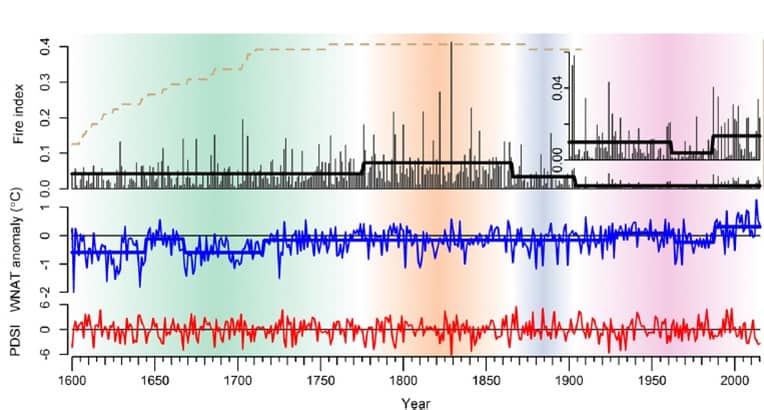
This is the second of the two papers on how past human activities have affected current conditions. This is relevant to our understanding of what we see today, as well as any reference points for Historic or Natural ranges of variation. What I really liked about this 2016 paper is that it tackled the history of the Sierra Nevada specifically related to fire.
I first found the description of the study in this post by Leny Quinn-Davidson of the Fire Adapted Communities Learning Network. Here is a link to the original paper, which is also worth reading, especially for those who don’t know much California history and/or find it interesting. The excerpts below are all from the Quinn-Davidson post.
The authors identified four major fire regime periods since 1600, which they were able to link to patterns of human activity. The first regime shift occurred in 1776, triggering a 90-year period of enhanced fire activity. During that period, the mean fire index was almost twice what it had been before 1775. The paper shows that this regime shift was coincident with the timing of Native American contact with Spanish missionaries in the region, which occurred in 1769. It’s not exactly intuitive, but the authors explain that the decimation of Native Americans—and a subsequent reduction in light burning—allowed for an increase in fuel continuity and wildfire activity during that period. This connection is further evidenced by the increased sensitivity of fire activity to climate—a relationship that was relatively weak when Native Americans were conducting widespread burning.
The second regime shift occurred in 1866, at which point fire activity dropped back to pre-1776 levels. The authors attribute this shift to major land use changes across the region—mostly associated with intensive livestock grazing, which denuded herbaceous vegetation and had notable effects on fuel continuity and fire spread. During this period, fire activity was also less sensitive to climate than it had been during the previous period because of a lack of fuels.
The third shift is the one we’re all most familiar with: the beginning of the fire suppression era in the early 1900s. During the fire suppression period, in which we’re still operating today, fire activity has been 4–8 times less than in any other period in recent history. Likewise, the fire-climate relationship has been weak for most of this period; the 20th century has shown increased warming trends, yet fire activity has largely been squelched by human activity. Only in recent decades have we seen a strengthening of that relationship, as a perfect storm of high fuel accumulations, longer fire seasons and drier conditions enables fires of unprecedented severity and size, appearing to override the moderating effects of human management.
But the really valuable thing about this new paper by Taylor et al. is that it gives us a larger context to work within. Yes, recent decades have had increased fire activity and increased sensitivity to climate—we’ve all seen it. But let’s remember that our collective frame of reference is relatively short; for most of us, our vision of what’s natural or normal in terms of fire comes from the mid to late 20th century—the height of our fire disconnect. This paper allows us to look back and see that the human relationship to fire is enduring and powerful, and that our biggest mistake in the last century has been to deny ourselves that intimacy—to value “nature” over nurture. History tells us that we should be able to buffer climate effects, but only if we actively engage at a grand scale. I think we’re ready.
“History tells us that we should be able to buffer climate effects, but only if we actively engage at a grand scale.” “Buffering” is an interesting way to put it. In this context, it seems to mean “keep fires from burning the way they want to. Thus, past “buffering” was the result of 1) indigenous burning, 2) livestock grazing (I assume associated land clearing was part of this, too), and 3) active fire suppression. I don’t think any of those are the keys to sustainability today. In fact, I think the concept of sustainability would point toward finding ways for burning to occur more in line with the climate and vegetation.
I’m not in favor of letting so many of today’s human-caused wildfires to be “…burning the way they want to.”